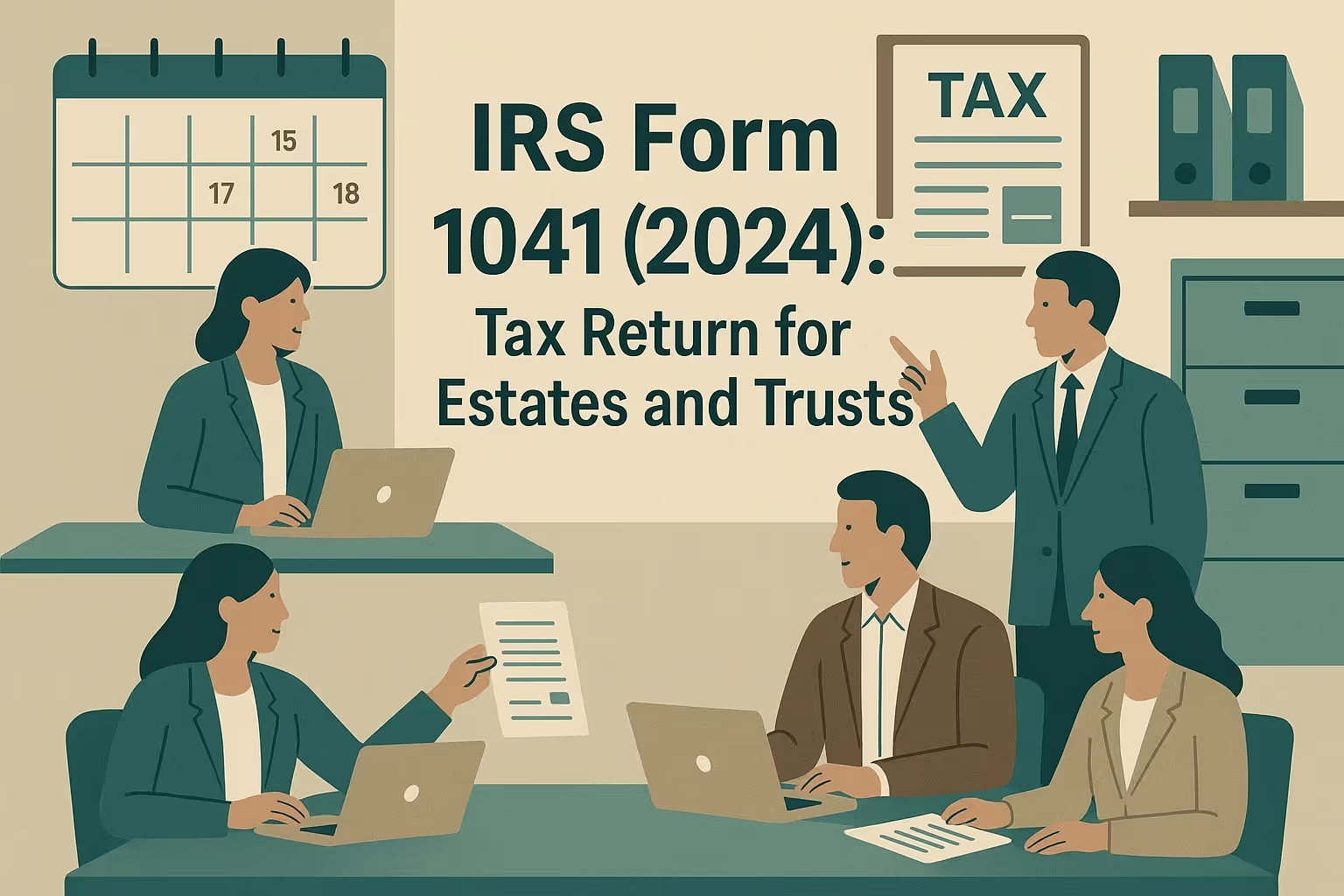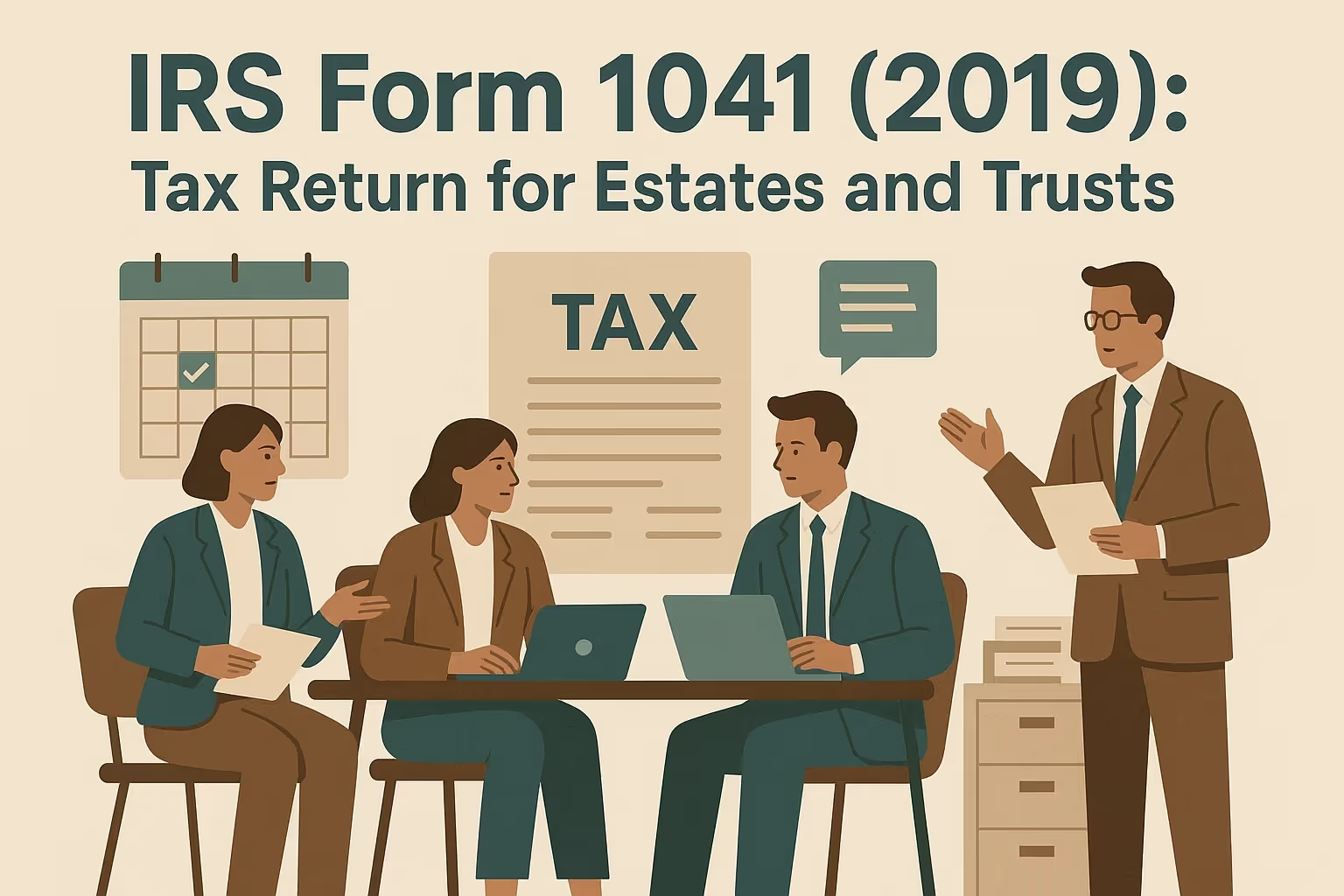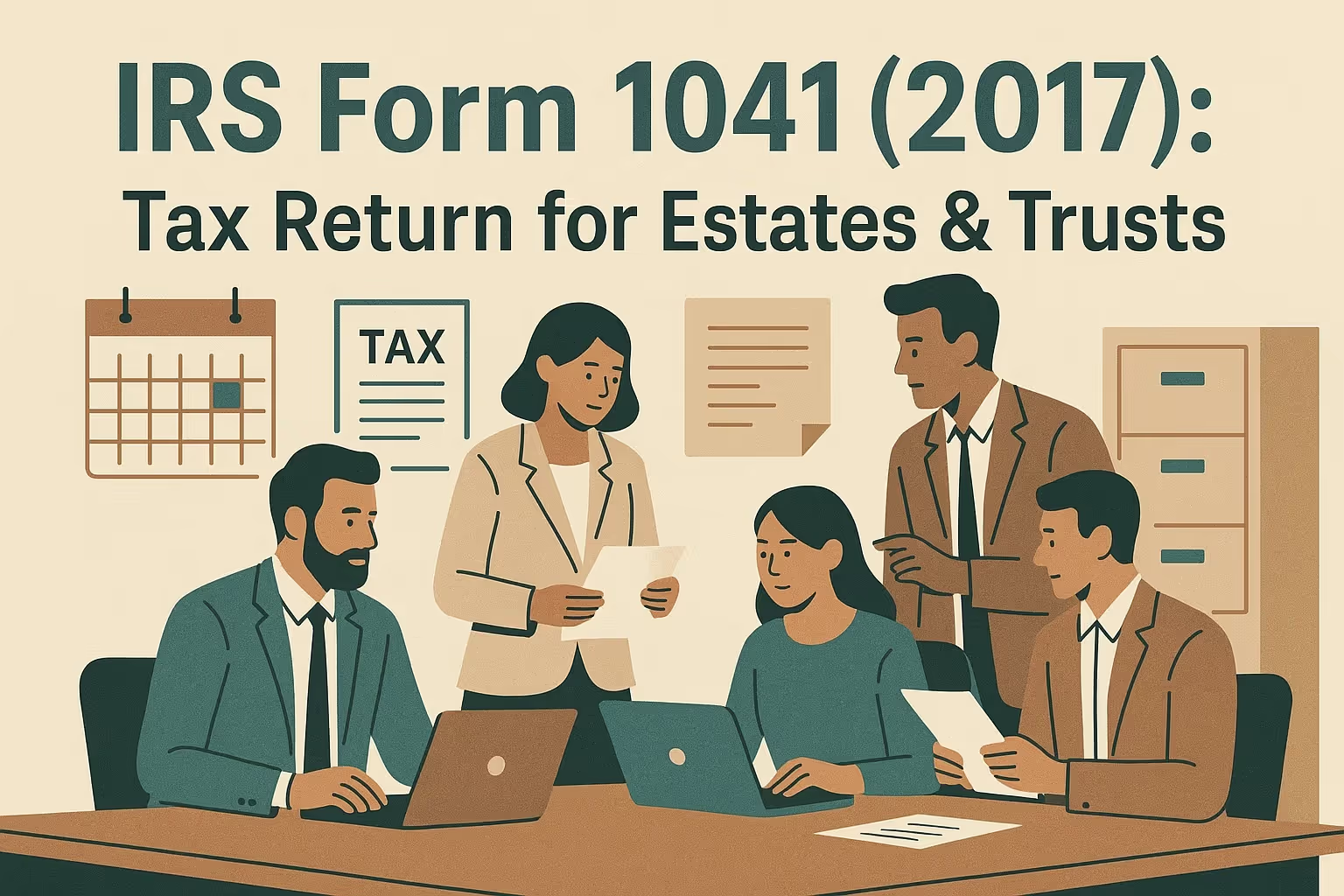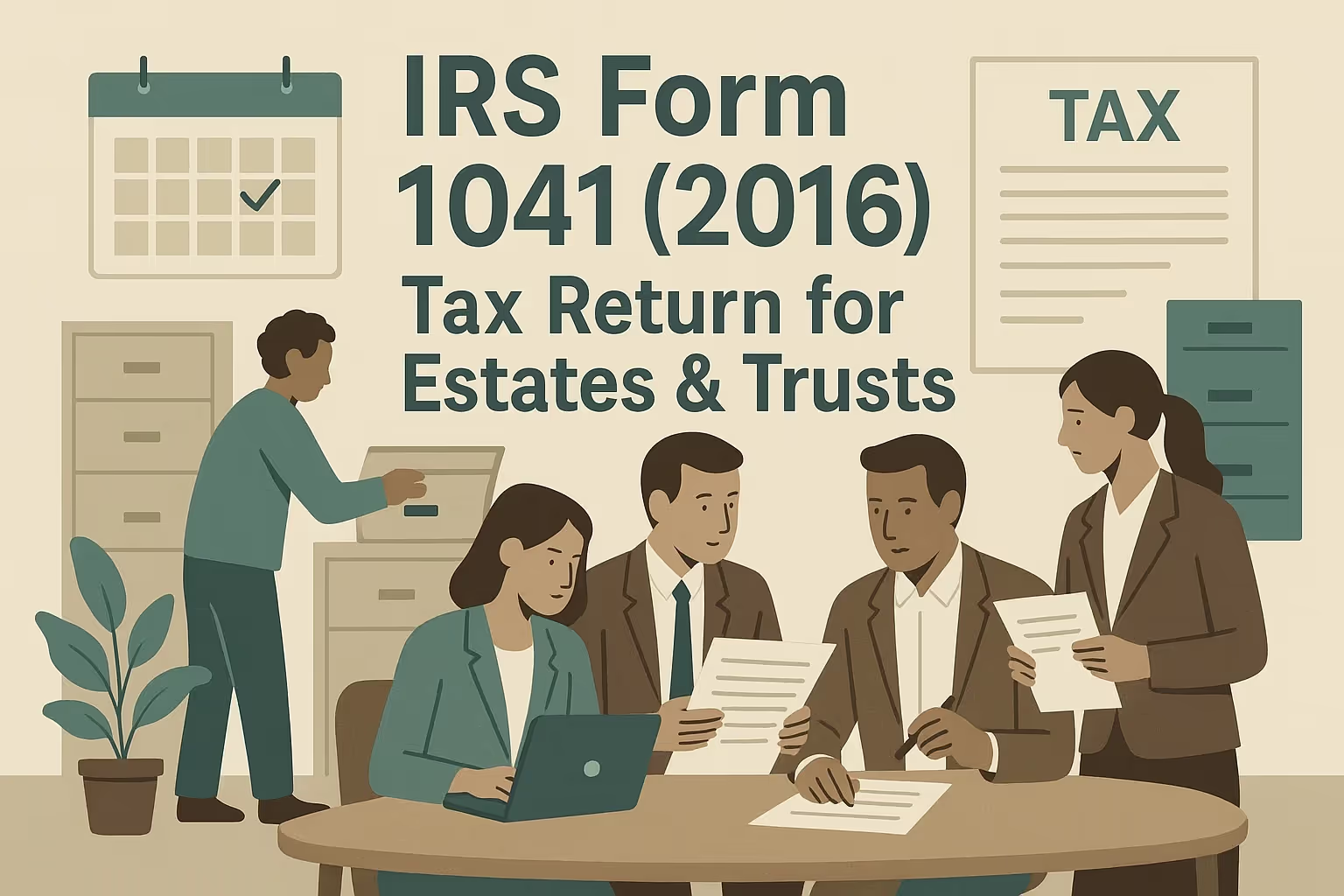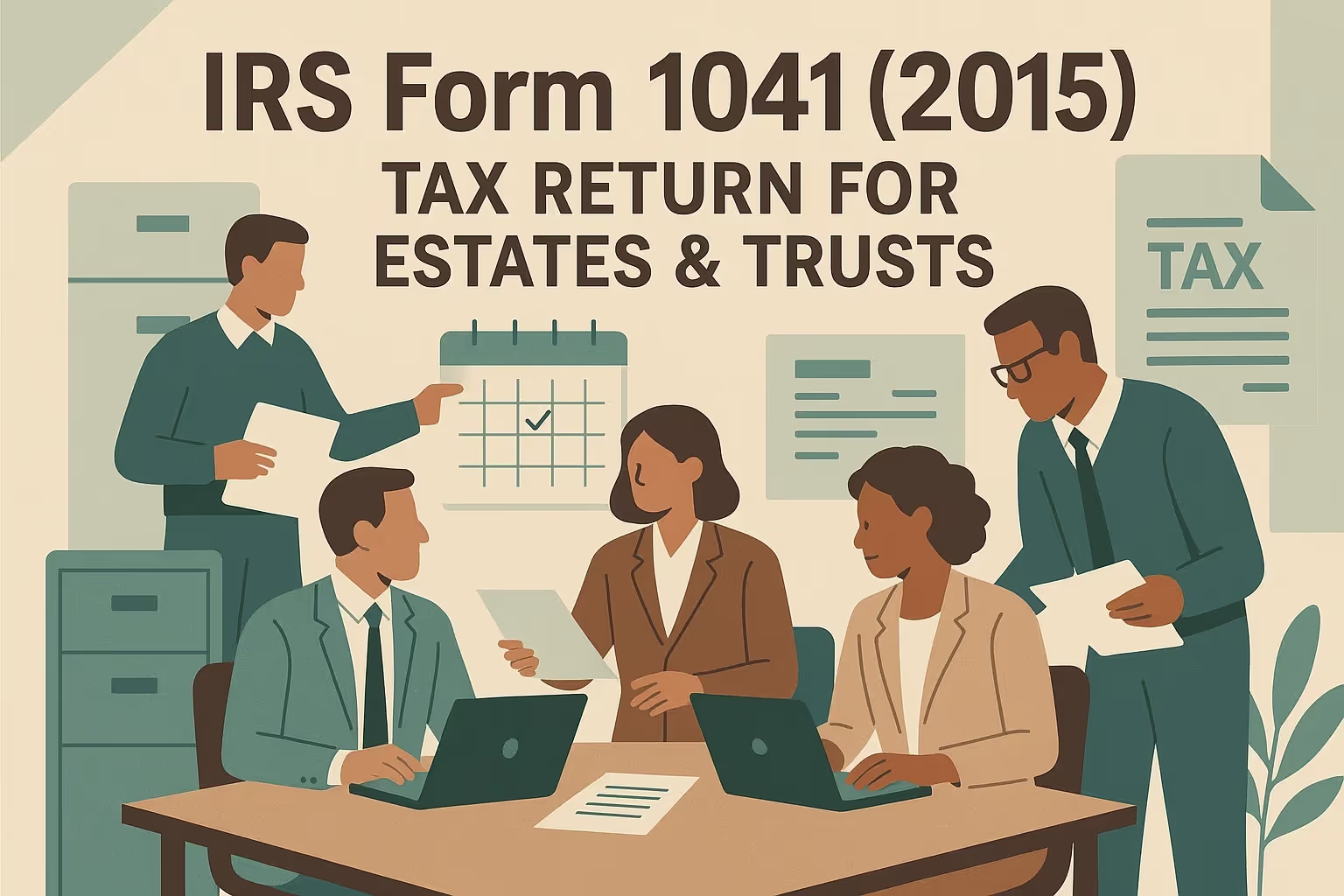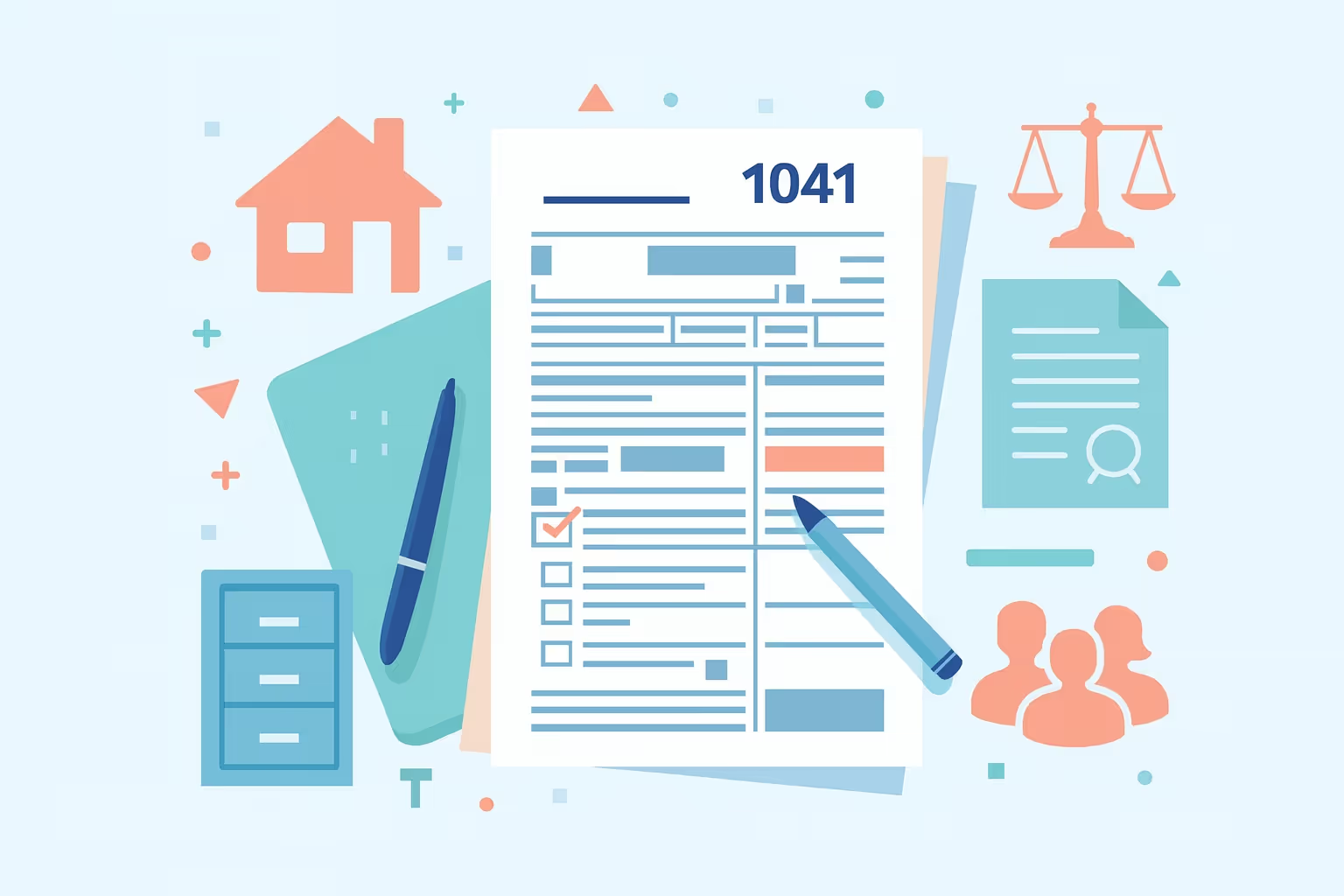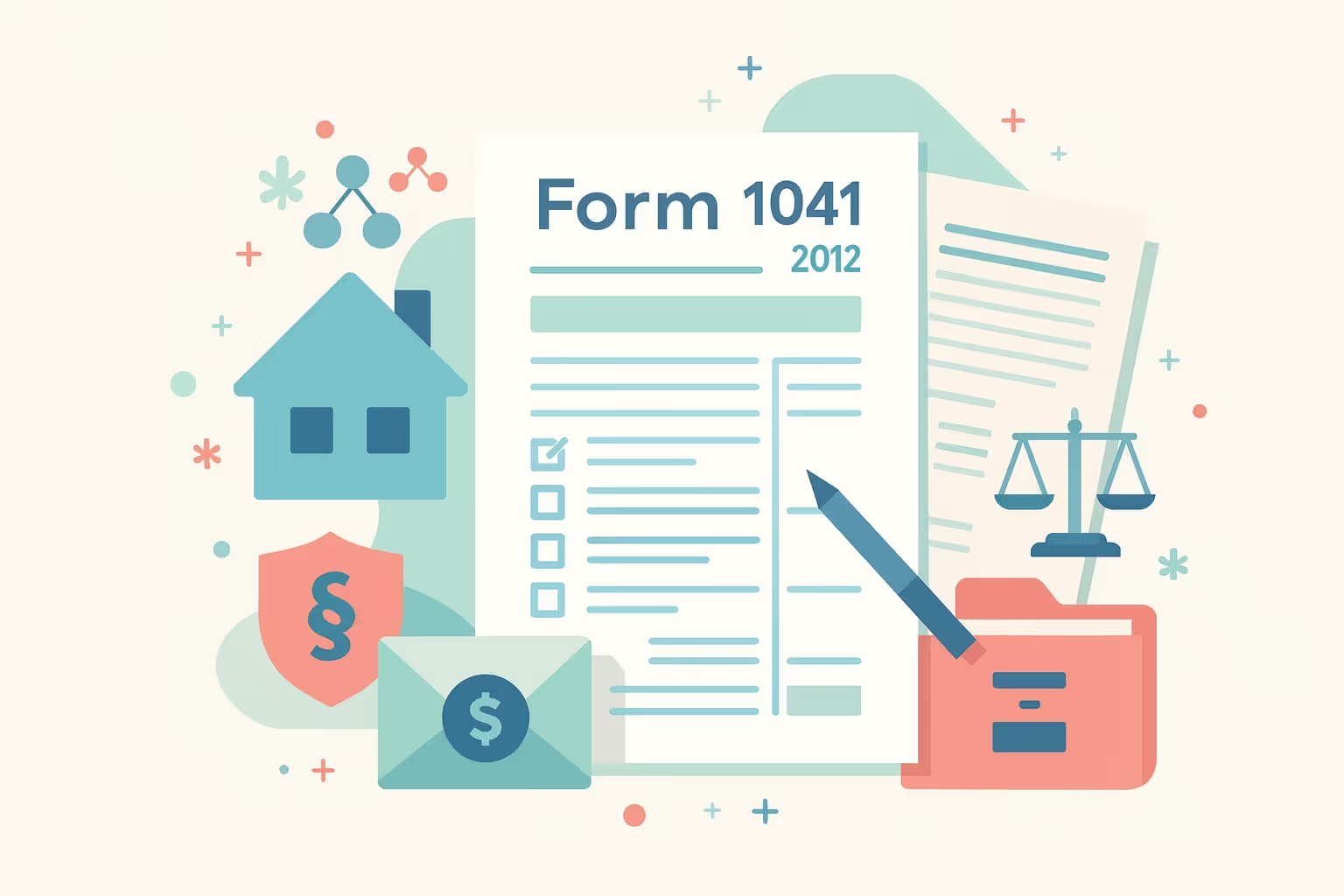Form 1041 2015 Instructions: Estate & Trust Tax Guide
Filing Form 1041 is a crucial step in managing an estate or trust after the death of a person. The Internal Revenue Service requires this income tax return to report income, deductions, and distributions related to the assets of a domestic decedent's estate or trust. For many fiduciaries, this form may seem complex, especially when preparing it for a past tax year such as 2015. However, understanding its structure and purpose helps ensure compliance and accuracy when reporting income earned or distributed to beneficiaries.
Form 1041 serves as the tax return for estates and trusts, similar to a personal income tax return but explicitly designed for fiduciaries acting on behalf of another entity. Executors, trustees, or personal representatives are responsible for reporting income generated by the estate’s or trust’s property, including interest, dividends, capital gains, or rental income. The Internal Revenue Code outlines these reporting requirements to ensure that income taxes are properly assessed based on total income and allowable deductions.
This guide provides clear and practical instructions for filing Form 1041 in 2015. It breaks down each step of the process, from obtaining an Employer Identification Number to completing the necessary schedules, such as Schedule K-1. Whether the estate had active income or was closing during the 2015 tax year, these instructions help fiduciaries file correctly, calculate taxable income, and meet all filing obligations with confidence.
Understanding Form 1041 and Its Purpose
Form 1041, known as the U.S. Income Tax Return for Estates and Trusts, is issued by the Internal Revenue Service for fiduciaries who must report income earned, deductions taken, and distributions made from a domestic decedent’s estate or trust.
It functions much like a personal income tax return but applies to estates and trusts managed by fiduciaries after a person has passed away. This form ensures that any income generated by the estate’s or trust’s assets is reported for tax payment purposes under the Internal Revenue Code.
What Is Form 1041?
This form serves as the official income tax return for estates and trusts that have generated reportable income during a tax year. The filing covers income categories reported from various sources, including wages, interest, dividends, mutual funds, rental property, and savings accounts. It also includes income earned from capital gains or ordinary business income. Form 1041 helps determine taxable income and income tax liability for the estate or trust.
Who Must File Form 1041?
Filing requirements depend on the amount and type of income, as well as the entity’s structure.
- Estates must file if gross income for the tax year is $600 or more, or if any beneficiary is a nonresident alien.
- Trusts must file if they have any taxable income or gross income of $600 or more, even if no tax is owed.
- A bankruptcy estate must file if gross income meets the threshold set for individual returns under the Internal Revenue Code.
- A domestic decedent’s estate with income generated after death must also report through Form 1041.
Key Terms and Their Meaning
Understanding specific tax terms helps fiduciaries complete the form accurately.
- Fiduciary: The person legally responsible for managing the estate or trust, often an executor, trustee, or personal representative.
- Beneficiary: The individual entitled to receive the income or property distributed from the estate or trust.
- Gross income: The total income before deductions, including interest, dividends, capital gains, or rental payments.
- Taxable income: The portion of revenue remaining after all allowable deductions and credits are applied.
- Income distribution deduction: A deduction that reduces taxable income by the amount distributed to beneficiaries, preventing double taxation.
- Schedule K-1: A required form that reports each beneficiary’s share of income, deductions, and credits.
Examples of Income Reported on Form 1041
Common types of income include:
- Interest from savings accounts or certificates of deposit
- Dividends from mutual funds or stocks
- Rents collected from real property or investment holdings
- Wages paid to household employees
- Gains from the sale of assets, such as securities or real estate
These examples represent income generated by the estate or trust during the tax year and must be reported accurately to calculate total income and deductions.
Form 1041 plays a crucial role in ensuring the proper reporting and payment of income taxes for estates and trusts. It allows the Internal Revenue Service to verify that all income earned by an estate or trust is accounted for while also protecting beneficiaries from being taxed twice on the same distribution.
What’s New for Tax Year 2015?
For the 2015 tax year, several updates affected how estates and trusts filed their income tax returns. The most notable change involved the due date. Instead of the traditional April 15 deadline, returns for this year were due on April 18, 2016, or April 19 for residents of Maine and Massachusetts due to the Patriots’ Day holiday. This adjustment gave fiduciaries additional time to file without penalty.
Updated Capital Gains Tax Rates
The capital gains tax brackets for estates and trusts were adjusted for the 2015 tax year.
- A 0% rate applied to income up to $2,500.
- A 15% rate applied to income between $2,501 and $12,300.
- A 20% rate applied to income above $12,300.
These thresholds influenced how fiduciaries calculated income tax liability on investments or property sales reported as capital gains.
Qualified Disability Trust Exemption
The exemption amount for qualified disability trusts increased to $4,000 for the 2015 tax year. The exemption began phasing out for trusts with modified adjusted gross income above $258,250. This change affected the calculation of taxable income for trusts supporting disabled beneficiaries.
Bankruptcy Estate Filing Threshold
Bankruptcy estates were required to file Form 1041 if gross income was $10,300 or more. This reflected an increase consistent with inflation adjustments applied to personal income tax return thresholds.
These updates highlight how minor adjustments in tax law can affect the filing process and emphasize the importance of reviewing annual instructions before filing.
Step-by-Step Guide to Completing Form 1041
Step 1 – Gather Required Information.
Before beginning, fiduciaries should gather all relevant documentation related to the estate or trust. This includes:
- Obtain an employer identification number (EIN) from the IRS.
- File Form 56 to notify the IRS of the fiduciary relationship.
- Review the will, trust agreement, or other governing documents.
- Collect all income statements, such as Forms 1099, W-2, or K-1.
- Gather receipts and records for deductible expenses.
- Confirm whether the entity is an estate, trust, or bankruptcy estate.
- Verify if the entity follows a calendar year or a fiscal year.
- Prepare bank statements and records of all assets held.
Having complete documentation ensures accurate reporting and reduces delays when calculating total income and deductions.
Step 2 – Determine Filing Requirements.
The fiduciary should confirm whether filing is required.
- Identify if the entity is a domestic estate, trust, or bankruptcy estate.
- Review the gross income amount for the 2015 tax year.
- Determine if any beneficiaries are nonresident aliens.
- Verify whether the estate or trust generated income after the decedent’s death.
If any condition applies, filing Form 1041 is required for that tax year.
Step 3 – Choose Tax Year and Accounting Method.
New estates may select either a calendar year ending on December 31 or a fiscal year ending on the last day of any other month. Once chosen, the method must remain consistent unless the IRS grants approval for a change. Fiduciaries must also select an accounting method:
- Cash method: Reports income when received and deductions when paid.
- Accrual method: Reports income when earned and deductions when incurred.
Step 4 – Complete Form 1041 Sections.
Form 1041 consists of three major parts:
- Income section (Lines 1–8): Report income earned, such as interest, dividends, and capital gains.
- Deductions section (Lines 10–18): Include deductible expenses like fiduciary fees, taxes, and interest paid.
- Tax computation (Lines 20–23): Calculate total tax owed based on taxable income and applicable credits.
Step 5 – Include All Required Schedules.
Several schedules may apply depending on the estate’s or trust’s activity.
- Schedule A: Charitable deduction.
- Schedule B: Income distribution deduction.
- Schedule D: Capital gains and losses.
- Schedule G: Tax computation.
- Schedule K-1: Beneficiary’s share of income, deductions, and credits.
After reviewing all completed sections, fiduciaries should verify totals, attach supporting forms, and confirm that every page is signed before submission.
How to File Form 1041?
E-Filing (Recommended)
E-filing is the preferred method for submitting Form 1041. It improves accuracy, reduces processing time, and provides confirmation of receipt. Fiduciaries must use an authorized IRS e-file provider and include Form 8879-F or Form 8453-FE for signature authorization. E-filing is especially useful for complex trusts or estates with multiple schedules, as errors are automatically flagged before submission.
Paper Filing
Paper filing remains an option when electronic submission is unavailable or the fiduciary prefers physical documentation. To file by paper, fiduciaries should print official IRS forms, sign them, attach all required schedules, and mail the package to the correct processing center. The address varies depending on location and whether payment is included. The form must be postmarked by the due date, which is the 15th day of the fourth month following the end of the tax year, or the next business day if that date falls on a weekend or holiday.
Review Before Filing
Before submission, the fiduciary should:
- Review every section for completeness and accuracy.
- Ensure that the totals in the income, deduction, and tax computation areas match the totals in the attached schedules.
- Verify that the EIN and tax year are correct.
- Keep a full copy of the return and confirmation record for future reference.
Submitting an accurate and timely Form 1041 enables estates and trusts to fulfill their tax responsibilities efficiently, preventing delays in beneficiary distributions.
Making Payments and Estimated Taxes
Fiduciaries are responsible for ensuring that all income taxes owed by an estate or trust are paid on a timely basis. Payments must be made by the due date of the return, even if the fiduciary files for an extension of time. Failure to pay on time can result in penalties and interest.
Payment Due Dates and Extensions
The 2015 tax year deadline for most estates and trusts was April 18, 2016, or April 19 for residents of Maine and Massachusetts. Fiduciaries may request additional time to file using Form 7004, but this extension does not postpone the payment deadline. Taxes were still due on the original deadline, typically the 15th day of the fourth month following the end of the tax year.
Payment Methods
Fiduciaries can pay electronically or by paper.
- Electronic options: The IRS Direct Pay system, the Electronic Federal Tax Payment System (EFTPS), and approved credit or debit card processors allow secure and immediate transactions.
- Paper payments: Checks or money orders should accompany Form 1041-V, the payment voucher, and be payable to the United States Treasury. Each payment should include the employer identification number and the applicable tax year.
Estimated Tax Payments
If an estate or trust expects to owe $1,000 or more after credits and withholding, estimated tax payments are required. These are made quarterly using Form 1041-ES. Payment dates for the 2015 tax year were April 15, June 15, September 15, and January 15 of the following year. Fiduciaries may also allocate payments to beneficiaries using Form 1041-T to credit each beneficiary’s share accurately.
Proper payment management helps avoid unnecessary interest charges and ensures compliance with Internal Revenue Service requirements.
Required Attachments and Supporting Documents
Every Form 1041 must include required schedules and supporting documents that explain or verify the reported figures. These attachments help confirm that all deductions, distributions, and credits have been accurately calculated and reported.
Schedule K-1 (Beneficiary’s Share)
Schedule K-1 reports each beneficiary’s share of income, deductions, and credits. It must be provided to every beneficiary by the filing due date. The schedule includes income categories reported to the IRS, such as interest, dividends, capital gains, and deductions passed through to beneficiaries. Each beneficiary uses this information to report their income on a personal income tax return.
Other Required Schedules and Forms
The following schedules and forms may be necessary depending on the activity of the estate or trust:
- Schedule A: Reports charitable deductions made by the estate or trust.
- Schedule B: Calculates the income distribution deduction for beneficiaries.
- Schedule D: Reports capital gains and losses from the sale of property or investments.
- Schedule G: Summarizes the tax computation for the estate or trust.
- Schedule I: Reports the alternative minimum tax when applicable.
- Schedule J: Calculates accumulation distributions for complex trusts.
- Form 56: Notifies the IRS about the fiduciary relationship.
Additional Documentation
Other attachments may include:
- A copy of the will or trust instrument, especially for first-time filings.
- Statements explaining deductions or unusual transactions.
- Proof of tax payments or estimated payment allocations.
- Documents showing foreign trust ownership or assets held abroad.
Providing complete and accurate attachments prevents IRS delays and supports proper verification of the income and deductions reported on the return.
Common Filing Errors and How to Avoid Them
Fiduciaries frequently encounter preventable mistakes when preparing Form 1041. Recognizing these errors before filing helps maintain accuracy and avoid penalties.
Frequent Errors
- Incorrect or missing employer identification number: Every estate or trust must have its own EIN, separate from the decedent’s Social Security number.
- Wrong filing threshold: Some fiduciaries file when not required or fail to file when they should. Always verify gross income amounts and beneficiary status.
- Mathematical mistakes: Calculation errors on taxable income or deductions can trigger notices from the IRS. Using tax software or a preparer helps reduce errors.
- Missing schedules or attachments: Each beneficiary must receive a completed Schedule K-1. Missing or incomplete schedules cause return rejections.
- Improper tax year selection: Estates can choose fiscal or calendar years, but trusts must generally follow a calendar year. Changing the period later requires approval from the IRS.
- Missing signature or incorrect title: The fiduciary must sign using the correct title—executor, trustee, or administrator—along with the date.
Recordkeeping and Review Tips
- Keep detailed records of all income earned, expenses paid, and assets distributed.
- Retain supporting documentation for at least three years after filing.
- Review all figures for consistency between schedules and main form entries.
- Recheck the EIN, tax year, and all totals before submission.
By carefully reviewing the return and confirming every required item, fiduciaries can minimize the risk of delays, penalties, or audits.
Zero-Activity or Dormant Estates and Trusts
Some estates or trusts may experience little to no activity during a tax year, in which case no filing is required in certain situations. However, understanding when to file and when to skip filing helps fiduciaries remain compliant.
When Filing May Not Be Required?
- The estate or trust earned less than $600 in gross income during the tax year.
- No nonresident alien beneficiaries were involved.
- The entity had no taxable income or income distributions.
Benefits of a Protective Filing
Even if no filing is required, submitting a return can provide advantages.
- It starts the statute of limitations period for the tax year.
- It serves as proof that no income was generated.
- It provides documentation for future audits or beneficiary inquiries.
Filing a Final Return
When an estate or trust closes, the fiduciary must file a final Form 1041 with the IRS.
- Check the “Final Return” box on the form.
- Distribute any remaining assets to beneficiaries.
- Provide final Schedule K-1 forms to each beneficiary.
Filing a protective or final return ensures all tax obligations are settled and confirms that no further filings are necessary once the estate or trust is closed.
Tips for First-Time Fiduciaries
Serving as a fiduciary carries legal and financial responsibilities. Understanding these duties helps prevent mistakes and ensures compliance with tax laws.
Initial Actions
- Apply for an Employer Identification Number (EIN) immediately after being appointed.
- File Form 56 to notify the IRS of your fiduciary authority.
- Open a separate bank account for the estate or trust.
- Notify financial institutions and agencies of the change in ownership.
Recordkeeping and Documentation
- Maintain clear records of all income earned, expenses paid, and distributions made.
- Keep receipts, bank statements, and copies of tax filings.
- Use a simple tracking system or spreadsheet to keep track of transactions.
- Retain records for at least three years after filing the return.
When to Seek Professional Help?
- The estate or trust owns complex assets or business interests.
- There are multiple beneficiaries or disputes among them.
- You are unsure about deductions, credits, or income categories reported.
- A tax professional or attorney can ensure the return meets IRS standards.
Good organization and timely reporting make it easier to manage fiduciary duties and maintain compliance with the Internal Revenue Code.
Frequently Asked Questions
Who needs to file Form 1041 for the 2015 tax year?
A fiduciary must file Form 1041 if a domestic decedent’s estate or trust earned $600 or more in gross income during the tax year or if any beneficiary is a nonresident alien. This income tax return reports income generated, deductions claimed, and taxes owed. It ensures the Internal Revenue Service receives accurate information about income taxes due from estates and trusts.
Can Form 1041 be filed electronically?
Yes, fiduciaries may e-file Form 1041 through authorized IRS e-file providers. Electronic filing ensures faster processing and confirmation of receipt. It also helps reduce errors when reporting taxable income, income distribution deduction, and tax credits. When e-filing, the fiduciary must include Form 8879-F or Form 8453-FE for signature authorization to complete the income tax return.
What income should be reported on Form 1041?
The fiduciary must report all income categories generated by the estate or trust, including wages, interest, dividends, capital gains, and income from rented property or mutual funds. Income earned after the person's passing must also be reported. This ensures that total income, taxable income, and any deductions are accurately calculated for tax payment purposes.
How is taxable income for estates and trusts calculated?
Taxable income is determined by subtracting allowable deductions, such as the income distribution deduction and fiduciary expenses, from total income. The Internal Revenue Code allows credits to offset income tax liability. Estates and trusts may also claim deductions for taxes paid, interest expenses, or charitable contributions before computing the final income tax owed.
When should beneficiaries receive Schedule K-1?
Each beneficiary should receive Schedule K-1 by the due date of Form 1041. This form lists the beneficiary’s share of income, deductions, and credits from the estate or trust. Beneficiaries use this information to complete their personal income tax return. Accurate K-1 reporting ensures income is distributed correctly and prevents double taxation under IRS rules.
How are payments made for Form 1041?
Fiduciaries can make payments electronically through the IRS Direct Pay system, EFTPS, or by check with Form 1041-V. Payments are due on the 15th day of the fourth month after the end of the tax year. Paying on time helps avoid penalties, interest, and ensures the estate or trust remains compliant with federal income tax regulations.






